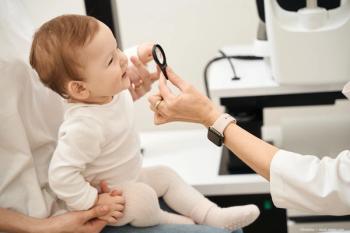
NeuroOp Guru: Evidence-based evaluation for optic neuritis from 'big data' analysis
Andrew Lee, MD, and Andrew Carey, MD, sit down on another episode of the NeuroOp Guru to discuss evidence-based evaluation for optic neuritis from big data analysis
Andrew Lee, MD, and Andrew Carey, MD, sit down on another episode of the NeuroOp Guru to discuss evidence-based evaluation for optic neuritis from big data analysis
Video Transcript
Editor's note - This transcript has been edited for clarity.
Andy Lee, MD:
Hello and welcome to another edition of the NeuroOp Guru. I'm here with my good friend. Dr Drew Carey from Johns Hopkins. Hi Drew
Drew Carey, MD:
Hi. Dr Andy Lee.
Andy Lee, MD:
Today we're going to be talking about evidence based evaluation for optic neuritis from big data analysis and Dr Carey, what is big data?
Drew Carey, MD:
Big data is a term that refers to very large numbers, usually from a health system, or a insurance database, or Medicare based population. Something where it would be too large to peruse through individual patient charts, and it requires help of a statistician or other type of evaluation to try and get data out from things that are kind of pre-programmed into the record system.
Andy Lee, MD:
And how big was big in the methods of this study.
Drew Carey, MD:
In this study, it was 6.7 million medical charts were queried.
Andy Lee, MD:
It's pretty big.
Drew Carey, MD:
It is pretty big. Yeah.
Andy Lee, MD:
And what were the results here? If you could just walk us through these 2 tables here.
Drew Carey, MD:
Absolutely. Yeah. So what was done is, diagnosis of optic neuritis was queried from the data set, as well as neurologic and systemic inflammatory conditions. And then they looked at the overlap to see, you know, what associations were present. So out of 6.7 million charts, they identified 5,300 cases of optic neuritis, and about 52% of those were associated with some type of underlying etiology that could be identified or associated with. The most common one was multiple sclerosis, and that made up 21% of the optic neuritis cases. Which I think is is not surprising from, you know, data looking at the ONTT they found about 50% of patients were associated with having multiple sclerosis. Of course, that was a prospective study, and so they could follow patients for a long time out, and maybe they didn't meet diagnostic criteria for MS when they first had optic neuritis, but would develop it later.
Second most common was neuromyelitis optica spectrum disorder, and that made up about 11% of patients with optic neuritis that could be identified in this study. The third most common condition was gout, which was present in 4.2% of patients. Now I don't think the authors or anybody thinks that gout causes optic neuritis, but gout is a very common condition. Sjogrens [and] Sarcoid were both very common in the 3-4% range. And then less common things like rheumatoid arthritis, HLA-B27 associated diseases, lupus and mixed connective were in the 1-2% range. Things like Scleroderma, MOGAD, GPA or granumatosis with polyangitis and Beçhets were all in the less than 1%.
And there's a little caveat to that, this was looking at about 10 years or so of data, and we didn't really have a good test for MOGAD throughout that whole period of time. So it's possible there were a number of patients who had MOGAD and couldn't be diagnosed because we didn't have a lab test for it during that period of time. So the authors did a subset analysis of patients with the these high-risk conditions, and just looked over a 2 year period and looked at which conditions had the highest risk of having optic neuritis. And as far as that, it was neuromyelitis optica spectrum disorder had the highest rate of optic neuritis if you knew you had that condition, and that had a relative risk of about 1,200 compared to the normal population. Followed by MOGAD, which had a relative risk of about 900 compared to the normal population. And then MS, with about a relative risk of 125. Still very high-risk conditions, but certainly less common, things like Sarcoid, Beçhets, Sjogrens, associated disorders, and then Lupus and mixed connective tissue disorders.
Andy Lee, MD:
So what was conclusion of this big data analysis?
Drew Carey, MD:
Yeah, so optic neuritis was fairly common in the population. It was about 8 per 10,000 charts that existed. And that's keeping with with other studies where, on all the average, we think it's maybe like a 1 in 10,000 event in a population. Certainly not, you know–if you're looking at medical records, those patients are seeking medical care. About 48% of the patients were idiopathic or could not have a finding–an underlying cause identified. Multiple sclerosis was the most common, followed by neuromyelitis optica. And then neuromyelitis optica, and MOGAD had the highest rate of developing optic neuritis, followed by MS. And so the conclusions were, you know, you definitely want to be thinking about the demyelinating conditions, MS, NMOSD, and MOGAD when you're seeing patients with optic neuritis and other things that you should think about, not necessarily be testing for, but at least take a history and do some evaluations on an exam to see whether or not you need to think about those conditions. Things like Sarcoid, Beçhets, Sjogrens in patients who fit a clinical picture for that, or whose MRI does not look like or they don't have other clinical features to suggest a primary demyelinating condition would be other things to keep on the back of your head and to be concerned about.
Andy Lee, MD:
Do you have a take home message for the audience? Is more big data coming? Do you find this helpful? How is it supposed to help us?
Drew Carey, MD:
Yeah, I think big data studies are definitely on the rise. I think they can help us, you know, put together an evidence based differential. I think, you know, we like to think common things happen commonly, and if the patient doesn't have one of the common things that we see, you know, day-in and day-out, it can help us direct a workup. And if we can move towards, you know, value based care and cost saving approaches, you know, working down to differential in a risk oriented manner may help us, you know, make our healthcare system a little bit leaner. And if, as the electronic medical systems improve, you know, we can do reflex testing instead of shotgun testing, that may help to save healthcare dollars. And as the big data gets more and more refined, you know, we may be able to plug patient information into like a risk calculator that helps us, you know, think about what's the most concerning things to keep on your differential. Or you might have a physician assistant, AI guided tool that will use the medical chart and say, you know, we noted these things in the patient's history, like they have dry mouth, and they're on, you know, 3 different drops for dry eyes, and they're coming in with optic neuritis. Maybe you want to think about Sjogrens as an underlying etiology. So I think, you know, big data allows us to do analysis we couldn't do by hand, or find associations we can't do from small series. It allows for better diversity on sampling of patients that will give us more generalizable information.
Andy Lee, MD:
That's just fascinating Dr. Carey, thanks again for your time. That concludes another edition of the NeuroOp Guru.
Drew Carey, MD:
Thanks for having me.
Newsletter
Don’t miss out—get Ophthalmology Times updates on the latest clinical advancements and expert interviews, straight to your inbox.


















































.png)


